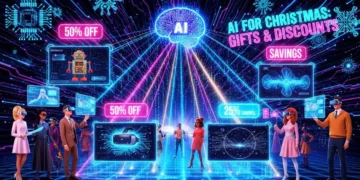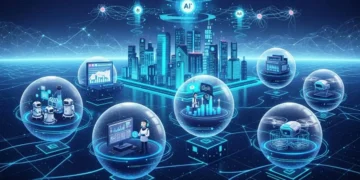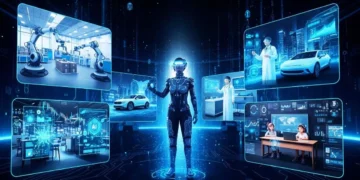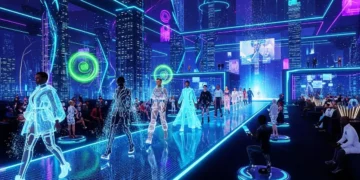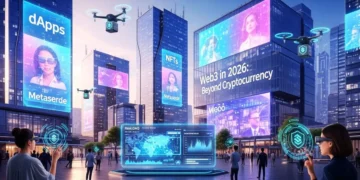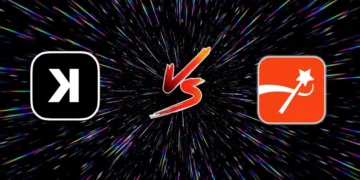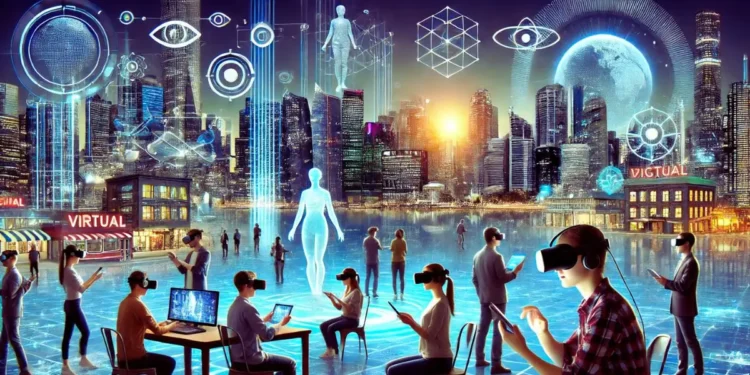Most people immediately think of virtual worlds filled with avatars and endless gaming possibilities when they hear the word “metaverse.” But here’s a question for you: Is the metaverse just about entertainment?
The truth is that the metaverse is evolving into something much more profound—a transformative force across sectors such as education, healthcare, retail, and real estate. In this article, we’ll explore how the metaverse is a powerful tool driving innovation in the real world, not just a playground for gamers.
What is the metaverse?
Before we dive deeper, let’s clarify what the metaverse is. It refers to a collective virtual shared space created by the convergence of virtually enhanced physical reality and persistent virtual spaces. Imagine an interconnected network of 3D environments where users can interact with each other and digital objects in real time.
This concept isn’t entirely new. Platforms like Second Life offered a preview of what was possible. Today’s metaverse, however, goes far beyond that by integrating advanced technologies such as augmented reality (AR), virtual reality (VR), and blockchain to create immersive and interactive experiences.
How is the metaverse different from the real world?
One of the most common questions people ask is this: How is the Metaverse different from the real world?
While the real world is governed by physical laws and limitations, the metaverse offers a limitless environment where creativity and technology can flourish. For example:
- You can attend a virtual meeting on Mars.
- Explore historical events in 3D simulations.
- Try on clothes digitally before purchasing them.
While these experiences are impossible in the traditional sense, they are completely feasible in the metaverse. This flexibility makes the metaverse a valuable asset for consumers and businesses alike.
Why is the metaverse so popular?
The metaverse’s popularity stems from its ability to offer immersive experiences that traditional platforms cannot match. As remote work and digital interactions have increased, the demand for engaging, real-time communication has grown.
The metaverse also allows brands to connect with customers in innovative ways. Imagine walking through a virtual store or attending a live concert from home. These scenarios aren’t science fiction; they’re happening now.
How is the metaverse different from the internet?
While the internet connects users through websites and apps, the metaverse provides a fully interactive, 3D environment. Think of it as stepping inside the web rather than just browsing it.
What distinguishes the metaverse from other traditional online platforms?
Persistent worlds: Unlike Second Life or MMORPGs, the metaverse doesn’t reset—it evolves continuously.
Interoperability: Digital assets (like NFTs) can move across platforms.
Decentralization: Many metaverse platforms use blockchain for user-owned economies.
Real-World Applications of the Metaverse
Healthcare Innovation Through Immersive Technology
In the medical field, the metaverse is transforming training and patient care. Surgeons can now practice complex procedures in a risk-free virtual environment. Patients benefit from VR-delivered therapies, which have shown promising results in treating conditions like PTSD and chronic pain.
Hospitals, for instance, are using metaverse-based simulations to train doctors and nurses, thereby reducing errors and improving outcomes. This kind of digital transformation is just the beginning of what’s possible.
💡 Case Study: A leading hospital in New York reported a 30% improvement in surgical precision after implementing VR-based training modules.
Education Reimagined: Learning in 3D
Traditional classrooms are being reimagined in the metaverse. Students can now take virtual field trips, conduct chemistry experiments without risking safety, and explore ancient civilizations firsthand.
Platforms like Engage XR and AltspaceVR allow educators to deliver content in engaging, interactive formats. This shift aligns with modern learning theories that emphasize experiential and participatory education.
Are you ready to imagine a classroom without borders?
Retail Revolution: Shopping Without Limits
Imagine trying on a dress in a virtual fitting room or strolling through a digital replica of your favorite store. That’s the power of the metaverse in retail!
Brands like Gucci and Nike have already launched metaverse fashion shows and virtual product lines. Customers can purchase digital items to wear in virtual environments, creating a new revenue stream.
Real Estate and Architecture: Building Futures Virtually
Developers and architects use the metaverse to design and showcase properties before construction begins. Potential buyers can take virtual tours, customize interiors, and experience how natural light affects a room at different times of day.
This application saves time and money while reducing the environmental impact associated with physical construction models.
Virtual Workspaces & Remote Collaboration
Companies like Microsoft (Mesh) and Meta (Horizon Workrooms) are building metaverse offices, allowing teams to collaborate in virtual reality as if they were physically present.
Healthcare & Virtual Surgery Training
Surgeons now use metaverse simulations to practice complex procedures, reducing risks in real-world operations.
Education & Immersive Learning
Students can explore ancient Rome or dissect virtual frogs, making learning more engaging than traditional online platforms.
Virtual Real Estate & Digital Economies
Platforms like Decentraland let users buy, sell, and monetize virtual land, creating a new asset class.
Social Interaction Beyond Social Media
Unlike video games, the metaverse fosters genuine social connections through virtual concerts, meetups, and even weddings.
What distinguishes the metaverse from other traditional online platforms?
Unlike traditional online platforms, which are often static and one-dimensional, the Metaverse is dynamic, persistent, and highly interactive. It supports real-time collaboration, user-generated content, and seamless integration across devices.
Furthermore, the metaverse uses blockchain technology to enable secure transactions and digital ownership, which most traditional platforms lack. These features create a more decentralized and user-driven ecosystem.
Metaverse vs. Video Games: Key Differences
A common misconception is that the metaverse is just gaming. But what sets them apart?
| Feature | Metaverse | Video Games |
|---|---|---|
| Persistence | Never resets | Resets per session |
| Economy | Real-money transactions (NFTs) | In-game currency only |
| Purpose | Work, socialize, learn, play | Primarily entertainment |
Is gaming the metaverse?
Although gaming is a significant part of the metaverse, equating the two would be a mistake. Games like Fortnite and Roblox have popularized the concept of shared virtual spaces, but they only represent a small part of the metaverse’s potential.
Think of it this way: If gaming is the tip of the iceberg, then the metaverse is the massive structure beneath the surface that supports everything from social interaction to economic systems.
🧐 Question for you: Do you think platforms like Minecraft or GTA Online qualify as early forms of the metaverse?
Why Did the Metaverse Fail (or Did It)?
There has been some talk about the metaverse failing. But is that true? Or is it simply evolving?
Early attempts at creating a fully realized metaverse were met with challenges such as poor hardware adoption, limited internet speeds, and unclear use cases. However, as technology advances and consumer behavior shifts, renewed interest and investment in the metaverse is growing.
Companies like Meta, Microsoft, and Apple are investing billions to develop the infrastructure necessary for a fully functional metaverse ecosystem. While it may not be everywhere yet, the metaverse is definitely on the rise.
Benefits of the Metaverse
Why is the metaverse so popular? Here’s why businesses and users are embracing it:
✅ Enhanced remote work with lifelike avatars
✅ New revenue streams (NFTs, virtual real estate)
✅ Immersive education beyond textbooks
✅ Global socialization without physical limits
FAQs
1. How is the metaverse different from the real world?
The metaverse is a digital twin of reality but with programmable physics, unlimited spaces, and virtual identities.
2. Why is the metaverse so popular?
Its blend of VR, blockchain, and social interaction offers limitless possibilities beyond traditional online platforms.
3. What are two applications of the metaverse?
Virtual offices for remote teams
Healthcare training via VR simulations
4. What is the difference between metaverse and video games?
Video games are closed systems for entertainment, while the metaverse is an open, persistent digital universe.
5. Why did the metaverse fail?
Early hype outpaced tech readiness, but long-term real-world applications suggest it’s far from dead.
6. What is the difference between metaverse and mixed reality?
Mixed reality (MR) blends physical and digital worlds, while the metaverse is a fully virtual ecosystem.
7. How is the metaverse different from Second Life?
Second Life is a single platform, whereas the metaverse is an interconnected network of virtual worlds.
8. Is gaming the metaverse?
No—gaming is just one aspect. The metaverse includes work, commerce, and social experiences.
Conclusion
The metaverse is more than just a gaming trend; it’s a revolutionary shift in how we work, learn, and connect. Although it’s still evolving, its real-world applications prove that it’s more than just a fad.
What do you think? Will the metaverse replace traditional workspaces, or is the hype overblown? Share your thoughts below!


